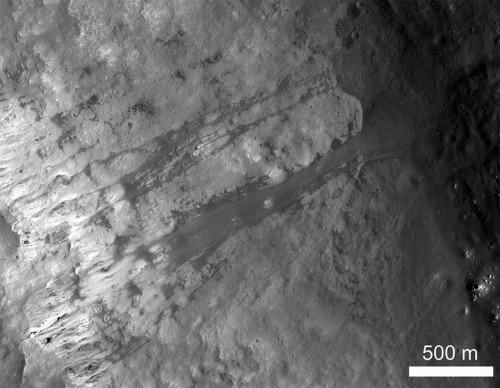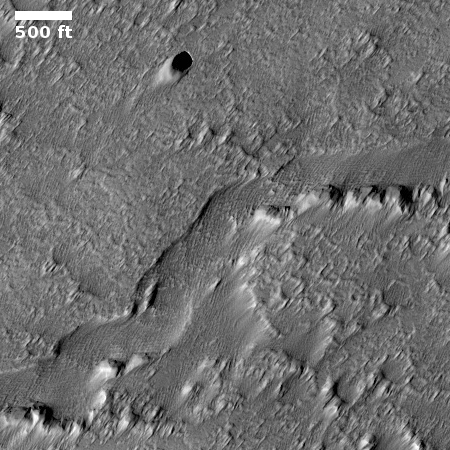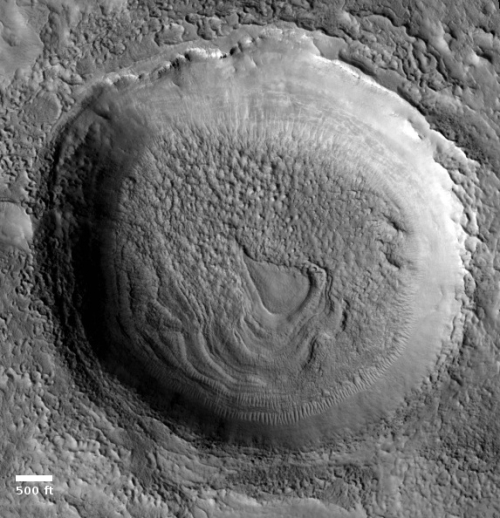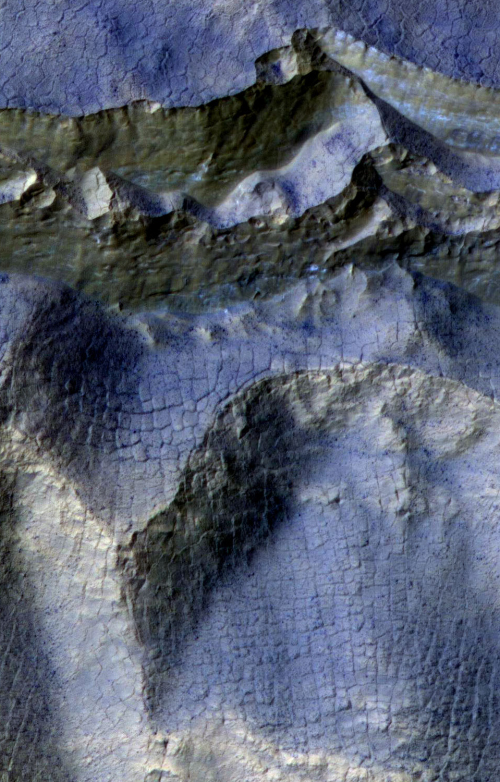A lunar landslide
Cool image time! The image to the right was posted by the Lunar Reconnaissance Orbiter (LRO) science team on October 9, 2020, and shows a spectacular landslide almost a mile and a half long that had occurred on the interior rim of a crater on the Moon.
The top of the rim is on the left, with the landslide breaking out onto the floor of the crater on the right.
The walls of Kepler crater (30 kilometer diameter) exhibit numerous landslides. In this example, a landslide of dark material begins about 100 meters below the rim from a narrow box canyon. The box canyon is about 50 meters wide and 300 meters long. Overall, the slide is extends some 2300 meters (from the end of the canyon to its base). The base of the slide is on a fault block that lies some 1800 meters below the rim. The wall slope is about 33 degrees.
This slide is actually composed of a series of narrow landslides 20-30 meters wide. Along most of the slope, the individual slides overrun each other forming a band of debris up to about 180 meters wide. At the base of the slope, the individual slides can be recognized as they move apart forming a fan of material. A few individual isolated slides also occur adjacent to the main mass. The overlapping nature of these small slides indicate that the overall feature may have formed over a period of time, rather than all at once.
From above and at this resolution, the landslide looks almost like frozen flowing liquid. It allso looks like it began with a scattering of boulders breaking free at the top all at once that quickly consolidated into a single massive avalanche.
At the link you can zoom in or out to look at the entire image, at full resolution.
Cool image time! The image to the right was posted by the Lunar Reconnaissance Orbiter (LRO) science team on October 9, 2020, and shows a spectacular landslide almost a mile and a half long that had occurred on the interior rim of a crater on the Moon.
The top of the rim is on the left, with the landslide breaking out onto the floor of the crater on the right.
The walls of Kepler crater (30 kilometer diameter) exhibit numerous landslides. In this example, a landslide of dark material begins about 100 meters below the rim from a narrow box canyon. The box canyon is about 50 meters wide and 300 meters long. Overall, the slide is extends some 2300 meters (from the end of the canyon to its base). The base of the slide is on a fault block that lies some 1800 meters below the rim. The wall slope is about 33 degrees.
This slide is actually composed of a series of narrow landslides 20-30 meters wide. Along most of the slope, the individual slides overrun each other forming a band of debris up to about 180 meters wide. At the base of the slope, the individual slides can be recognized as they move apart forming a fan of material. A few individual isolated slides also occur adjacent to the main mass. The overlapping nature of these small slides indicate that the overall feature may have formed over a period of time, rather than all at once.
From above and at this resolution, the landslide looks almost like frozen flowing liquid. It allso looks like it began with a scattering of boulders breaking free at the top all at once that quickly consolidated into a single massive avalanche.
At the link you can zoom in or out to look at the entire image, at full resolution.






